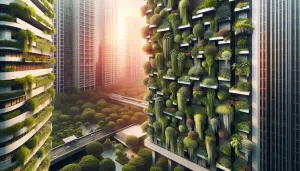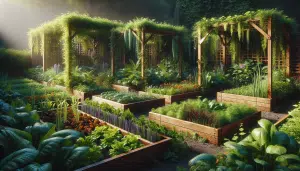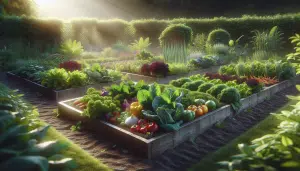Secrets You Should Know About Low Water Landscaping
Lily Carter September 21, 2025
Curious about transforming your outdoor space with less water and lower costs? Explore how low water landscaping brings lasting beauty, saves money, and supports the environment. Uncover creative strategies and practical tips for drought-tolerant gardens that keep lawns lush and vibrant, even in dry climates.
Understanding the Benefits of Low Water Landscaping
Low water landscaping, often called xeriscaping, is a growing trend among homeowners seeking beauty, practicality, and resource conservation. Instead of using thirsty lawns and plants, these gardens focus on native species and efficient design. What motivates many is the ability to significantly reduce water bills while still enjoying a lush yard. Landscape choices are made with local rainfall, soil, and weather in mind. This makes maintenance easier and more environmentally friendly. Those who embrace drought-tolerant gardening see enhanced curb appeal coupled with less outdoor work and fewer pests or weeds.
Lowering water usage brings several environmental and home care benefits. By choosing smart irrigation techniques and ground cover alternatives, homeowners actively decrease water waste. This kind of landscape supports pollinators and wildlife by incorporating native plants adapted to local ecosystems. You’ll also notice fewer chemical fertilizers or pesticides are required. Many local governments even offer incentives for converting lawns to more sustainable alternatives. This balanced approach not only elevates personal outdoor enjoyment but also encourages responsible stewardship of community water resources.
For those eager to boost property value or create more usable outdoor spaces, low water landscaping stands out. Potential buyers often look for yards that are attractive yet manageable, and efficient landscaping solutions can increase home value. In regions facing stricter water restrictions, these strategies may soon become necessities. Communities all over are discovering how thoughtfully designed gardens can deliver color, shape, and vibrancy with far less water. Explore further to learn how these design elements come together for eye-catching, sustainable yards.
Choosing Drought-Tolerant Plants for Every Space
Selecting appropriate plants is at the heart of every successful low water gardening project. Varieties like lavender, sedum, agave, and ornamental grasses require little irrigation but offer texture and color. Native plants often need the least attention since they thrive naturally in local conditions. Choosing trees and shrubs adapted to your climate not only ensures healthy growth but also reduces maintenance all year round. Succulents and groundcovers, such as creeping thyme or ice plant, can replace traditional grass while welcoming bees and butterflies.
A great design respects sunlight, shade, and soil type. Placing plants with similar water needs together makes irrigation even more efficient. Experiment with blooming perennials, drought-resistant annuals, or evergreens to keep outdoor spaces looking lively in all seasons. For shade, consider heuchera, Japanese forest grass, or hostas; for sun, rockrose, Russian sage, or rosemary thrive in dry conditions. Intermixing species promotes biodiversity and keeps pests at bay, further reducing the need for chemicals or interventions.
Integrating edible plants and herbs into a water-wise garden is easier than many assume. Mediterranean favorites like oregano, sage, and rosemary flourish with minimal water. Mulched herb beds or compact vegetable patches can offer fresh produce while still honoring conservation principles. The blend of culinary, ornamental, and native choices provides variety, scent, and color to the landscape. This way, gardens stay practical, beautiful, and aligned with eco-friendly values—no matter the size of the lot.
Soil Preparation and Mulching for Maximum Efficiency
Healthy soil lies at the foundation of any effective low water landscaping project. Amending sandy or compacted ground with compost increases its ability to retain moisture. Testing soil before planting can reveal simple ways to boost both structure and drainage. Organic matter, when worked into garden beds, encourages roots to dig deeper for water and nutrients. Looser, well-prepared beds reduce runoff and prevent water loss during dry spells. A solid start makes the difference between struggling plants and resilient, thriving growth throughout the year.
Mulching is essential for conserving soil moisture and controlling weeds. Materials such as bark chips, gravel, or shredded leaves create an effective barrier that limits water evaporation. Properly applied mulch also keeps root zones cool and suppresses weed seeds that compete for scarce resources. The right mulch brings a tidy, unified appearance to landscape beds while reducing ongoing maintenance requirements. Organic mulch slowly decomposes to further enrich the soil, while inorganic options excel at restraining weeds in high-traffic areas.
Incorporating groundcovers can also augment soil protection in bare spots or slopes that are vulnerable to erosion. Plants like creeping juniper or blue star creeper help hold soil together while providing seasonal green. Living mulches naturally shade the earth and block out competing weeds. They also create appealing color contrasts with taller trees or shrubs, turning functional soil protection into a key design feature. This powerful combination helps gardens withstand drought without sacrificing beauty or biodiversity.
Smart Irrigation Strategies That Really Work
Efficient irrigation is the secret weapon of drought-tolerant landscapes. Drip irrigation systems deliver water right to plant roots, minimizing waste through evaporation or runoff. Soaker hoses provide uniform moisture and are easy to install in established beds. Timers and moisture sensors can be fitted to conventional sprinklers, preventing overwatering and adjusting for unexpected rain. These tools bring customers peace of mind and free up time for enjoying the yard, not worrying about it.
Water-saving habits can stretch irrigation even further. Watering early in the morning or after sunset limits loss through evaporation. Targeting only areas in need reduces water use and supports healthier plant growth. Designating ‘hydrozones’—sections with similar water needs—helps avoid over- or under-irrigation across the yard. Learning to monitor soil moisture by touch or with inexpensive meters gives homeowners more control and confidence in their watering routine. Effective systems can be surprisingly affordable and pay for themselves in seasonal savings.
Rainwater harvesting offers extra flexibility. Simple rain barrels collect runoff from roofs and can be connected to drip lines or watering cans. Some municipalities provide rebates for installing capture systems, further reducing costs. Even without advanced gadgets, a focus on deep, infrequent watering (instead of shallow daily sprinkling) builds drought resistance naturally. Over time, combining improved irrigation, mulching, and plant selection drives higher water efficiency and healthier, more vibrant landscapes.
Creative Design Tips for Stunning Low Water Yards
Designing low water gardens doesn’t mean giving up lushness or color. Layering plants of different heights creates visual interest without dense plantings that consume more water. Grouping drought-hardy shrubs, perennials, and accent trees offers year-round form and structure. Decorative gravel, river stones, or stepping paths draw the eye while adding texture. Raised beds, rock gardens, and dry creek beds highlight water-wise features, replacing thirsty lawns or hard-to-irrigate slopes.
Adding art elements, boulders, or sculptural planters gives each garden a unique personality. Choose pots or containers made from natural materials and fill them with succulents for low-maintenance wow factor. Thoughtful lighting accents pathways or specimen plants, letting gardens shine even at night. Consider mixing bright flower patches with silvery-leaved ground covers to create movement and contrast. These design strategies let creativity flourish while staying within water-wise principles.
Paisley or geometric patterns in beds, bold focal points, or container groupings allow maximum visual impact with minimal upkeep. Working in seating areas or shaded patios highlights outdoor living potential. Many homes benefit from dividing spaces into ‘rooms’ using trellises or low walls—a technique which makes even modest yards feel expansive. Taking inspiration from Mediterranean, desert, or prairie landscapes can infuse the yard with regional character and charm while conserving precious resources.
Maintaining Healthy and Vibrant Drought-Tolerant Gardens
Ongoing care for drought-tolerant landscapes is both simple and rewarding. Regular monitoring helps catch pests, plant diseases, or irrigation issues early. Most established xeriscape gardens require little more than seasonal pruning, mulching, and occasional feeding. If any plants struggle, replacing them with hardier varieties is easy thanks to the flexibility of water-wise design. Adjusting irrigation through the seasons ensures that roots continue to grow deep, keeping plants resilient during heat waves or dry spells.
Weed control is easier in these gardens because fewer high-moisture spots remain for weeds to thrive. Frequent checks and manual removal, paired with mulch and groundcover, prevent major outbreaks. Deadheading flowers and trimming back spent foliage encourages further blooms. Some native plants may self-seed or spread, filling gaps without wasting water. Over time, gardens look fuller and healthier, with less effort and fewer inputs than traditional lawns or beds.
Finally, composting green waste creates a closed-loop system that further enriches soil and supports ongoing garden health. Using organic feed or soil amendments builds healthy, living soils that support the entire landscape. Sustainable gardening isn’t just a trend—it’s a solution to resource challenges and an investment in years of outdoor enjoyment. The beauty and diversity of water-efficient gardens can inspire entire neighborhoods to embrace conservation, one yard at a time.
References
1. United States Environmental Protection Agency. (n.d.). Water-Smart Landscapes. Retrieved from https://www.epa.gov/watersense/water-smart-landscapes
2. The Xerces Society. (n.d.). Xeriscaping With Native Plants. Retrieved from https://xerces.org/publications/fact-sheets/xeriscaping
3. California Department of Water Resources. (n.d.). Lawn Replacement Rebates. Retrieved from https://water.ca.gov/What-We-Do/Water-Conservation/Lawn-Replacement-Rebates
4. Missouri Botanical Garden. (n.d.). Drought-Tolerant Gardening. Retrieved from https://www.missouribotanicalgarden.org/gardens-gardening/your-garden/help-for-the-home-gardener/advice-tips-resources/gardening-help-faqs/drought-tolerant-gardening
5. Penn State Extension. (n.d.). Mulching for Healthy Landscapes. Retrieved from https://extension.psu.edu/mulching-for-home-gardens
6. North Carolina State University Cooperative Extension. (n.d.). Water-Wise Gardening. Retrieved from https://content.ces.ncsu.edu/water-wise-gardening







